See also
- Mr. Frank, the Underground Mail-Agent – Another satirical anti-Tom novel, released in 1853
| Author | William M. Burwell |
|---|---|
| Country | United States |
| Language | English |
| Genre | Plantation literature Satire |
| Publisher | J.W. Randolph Publishers |
Publication date | 1856 |
| Media type | Print (hardback & paperback) & E-book |
| Pages | c.100 pp (May change depending on the publisher and the size of the text) |
White Acre vs. Black Acre is an 1856 plantation fiction novel written by William M. Burwell.
White Acre vs. Black Acre is one of several pro-slavery novels published in the Southern United States in response to Uncle Tom's Cabin by Harriet Beecher Stowe, published in 1852. [1]
Burwell's novel, however, departs from the usual outline of most anti-Tom novels, which often narrated stories of loyal slaves serving benign plantation owners who were disturbed by troublesome abolitionists. [1] Instead, Burwell's novel acts as an allegory for the history of slavery in the United States, in a manner similar to George Orwell's Animal Farm , which acts as an allegory for the history of the Soviet Union.
The story follows the history of the United States from its time as a British province to the beginning of tensions between North and South in the 1850s. It is presented as though the story were being recounted by a retired barrister from Lincolnshire in England to a reporter from the United States. [2]
The story takes place in the county of Shropshire in England, where capitalist Mr. Bull is undergoing a difficult transaction with a large quantity of land his firm has since acquired from various lucrative business deals. His main rival is Don Armado, who owns land near his own, and seeks to steal Bull's land from him.
When Don Armado is placated, Mr. Bull takes his business elsewhere, and the land prospers. However, the two farmers tilling the land are suddenly split over the question of whether the land ought to be tilled by ordinary, ineffective farmhands or by loyal, hardworking slaves.
The land is thus split between the two farmers. The pro-slavery segment becomes the Black Acre Farm, whilst the anti-slavery land becomes the White Acre Farm, with both competing to see which side will be the most prosperous.
The novel was released in book form in 1856, and was printed by the same publishers of an earlier anti-Tom novel, Uncle Robin, in His Cabin in Virginia, and Tom Without One in Boston by J.W. Page (1853). [4]
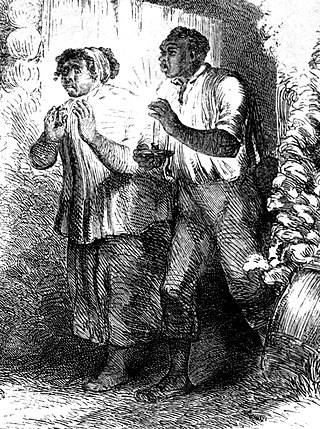
Uncle Tom is the title character of Harriet Beecher Stowe's 1852 novel Uncle Tom's Cabin. The character was seen by many readers as a ground-breaking humanistic portrayal of a slave, one who uses nonresistance and gives his life to protect others who have escaped from slavery. However, the character also came to be seen as inexplicably kind to white slaveholders, especially based on his portrayal in pro-compassion dramatizations. This led to the use of Uncle Tom – sometimes shortened to just a Tom – as a derogatory epithet for an exceedingly subservient person or house negro, particularly one aware of his or her own lower-class racial status.

Uncle Tom's Cabin; or, Life Among the Lowly is an anti-slavery novel by American author Harriet Beecher Stowe. Published in two volumes in 1852, the novel had a profound effect on attitudes toward African Americans and slavery in the U.S., and is said to have "helped lay the groundwork for the [American] Civil War".
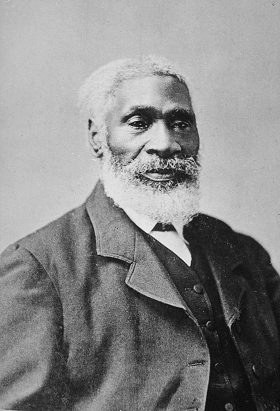
Josiah Henson was an author, abolitionist, and minister. Born into slavery, in Port Tobacco, Charles County, Maryland, he escaped to Upper Canada in 1830, and founded a settlement and laborer's school for other fugitive slaves at Dawn, near Dresden, in Kent County, Upper Canada, of Ontario. Henson's autobiography, The Life of Josiah Henson, Formerly a Slave, Now an Inhabitant of Canada, as Narrated by Himself (1849), is believed to have inspired the title character of Harriet Beecher Stowe's 1852 novel Uncle Tom's Cabin (1852). Following the success of Stowe's novel, Henson issued an expanded version of his memoir in 1858, Truth Stranger Than Fiction. Father Henson's Story of His Own Life. Interest in his life continued, and nearly two decades later, his life story was updated and published as Uncle Tom's Story of His Life: An Autobiography of the Rev. Josiah Henson (1876).

Anti-Tom literature consists of the 19th century pro-slavery novels and other literary works written in response to Harriet Beecher Stowe's Uncle Tom's Cabin. Also called plantation literature, these writings were generally written by authors from the Southern United States. Books in the genre attempted to show that slavery was beneficial to African Americans and that the evils of slavery, as depicted in Stowe's book, were overblown and incorrect.

Aunt Phillis's Cabin; or, Southern Life as It Is by Mary Henderson Eastman is a plantation fiction novel, and is perhaps the most read anti-Tom novel in American literature. It was published by Lippincott, Grambo & Co. of Philadelphia in 1852 as a response to Harriet Beecher Stowe's Uncle Tom's Cabin, published earlier that year. The novel sold 20,000–30,000 copies, far fewer than Stowe's novel, but still a strong commercial success and bestseller. Based on her growing up in Warrenton, Virginia, of an elite planter family, Eastman portrays plantation owners and slaves as mutually respectful, kind, and happy beings.

The Planter's Northern Bride is an 1854 novel written by Caroline Lee Hentz, in response to the publication of Uncle Tom's Cabin by Harriet Beecher Stowe in 1852.

Tom show is a general term for any play or musical based on the 1852 novel Uncle Tom's Cabin by Harriet Beecher Stowe. The novel attempts to depict the harsh reality of slavery. Due to the weak copyright laws at the time, a number of unauthorized plays based on the novel were staged for decades, many of them mocking the novel's social message, and leading to the pejorative term "Uncle Tom".
Uncle Robin, in His Cabin in Virginia, and Tom Without One in Boston is an 1853 novel written by J.W. Page and released by J. W. Randolph Publishers of Richmond, Virginia.
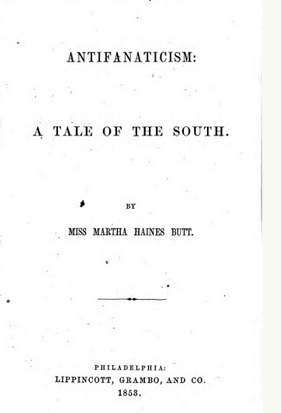
Antifanaticism: A Tale of the South is an 1853 plantation fiction novel by Martha Haines Butt.
Life at the South; or, "Uncle Tom's Cabin" As It Is is an 1852 plantation fiction novel written by William L.G. Smith.
The North and the South; or, Slavery and Its Contrasts is an 1852 plantation fiction novel by Caroline Rush, and among the first examples of the genre, alongside others such as Aunt Phillis's Cabin by Mary Henderson Eastman and Life at the South; or, "Uncle Tom's Cabin" As It Is by W.L.G. Smith, both of which were also released in 1852.
Frank Freeman's Barber Shop is an 1852 plantation fiction novel written by Baynard Rush Hall.
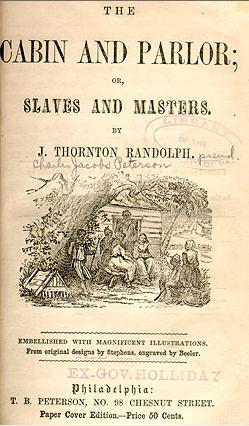
The Cabin and Parlor; or, Slaves and Masters is an 1852 novel by Charles Jacobs Peterson, writing under the pseudonym J. Thornton Randolph.
The Lofty and the Lowly, or Good in All and None All Good is a novel by Maria Jane McIntosh published by D. Appleton & Company in 1853. It was one of many anti-Tom novels published in response to Harriet Beecher Stowe's Uncle Tom's Cabin. The story is set is Georgia and tells of a plantation owner's efforts to avoid bankruptcy with the help of his loyal slave Daddy Cato. Their efforts are challenged by a northern usurer and devious northern capitalists. The book sold well across the United States upon release, making it one of the most successful anti-Tom novels in the middle 19th century.

Mr. Frank, the Underground Mail-Agent is an 1853 parody novel written by an unknown author credited as "Vidi".
Liberia; or, Mr. Peyton's Experiments is an 1853 novel by Sarah Josepha Hale, the author of the nursery rhyme "Mary Had a Little Lamb", who wrote the novel under the name of Sara J. Hale.
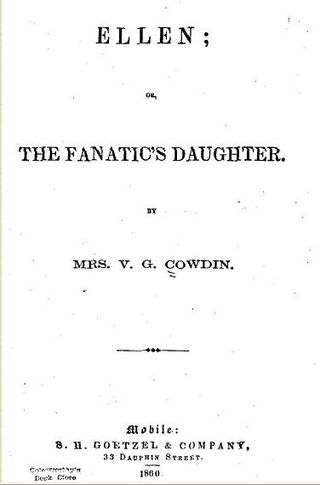
Ellen; or, The Fanatic's Daughter is an 1860 plantation fiction novel written by Mrs. V.G. Cowdin.
Tit for Tat is an 1856 novel written anonymously by "A Lady of New Orleans".
The Ebony Idol is a plantation literature novel by G. M. Flanders, first published in 1860. It is one of several pro-slavery novels written in the Southern United States in response to the 1852 abolitionist novel Uncle Tom's Cabin by Harriet Beecher Stowe.

Uncle Tom's Cabin is a 1927 American synchronized sound drama film directed by Harry A. Pollard and released by Universal Pictures. While the film has no audible dialog, it was released with a synchronized musical score with sound effects using the Western Electric sound-on-film process. The film is based on the 1852 novel Uncle Tom's Cabin by Harriet Beecher Stowe and was the last silent version filmed.